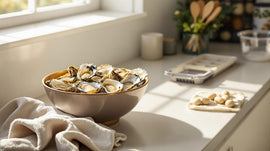Starting an oyster farm in Virginia requires specific permits to ensure safe, sustainable, and legal operations. Here’s a quick breakdown:
-
Who Needs Permits?
-
Commercial Farmers: For leased grounds and harvesters.
-
Aquaculture Product Owners: Must report harvests annually.
-
Harvesters: Permit required during work; minors supervised by adults are exempt.
-
Floating Gear Operators: Special permits for equipment above 12 inches.
-
-
Key Permits and Costs
-
Shellfish Aquaculture License: Mandatory, includes training every 5 years.
-
Aquaculture Product Owners License: $10 annually.
-
Annual Oyster Aquaculture User Fee: $50.
-
-
Health and Safety Rules
-
Follow strict summer harvesting protocols (May–October).
-
Use temperature-controlled storage for oysters immediately after harvest.
-
-
Hobby Farming
- Free permits for growing up to 1,000 oysters in a 160 sq. ft. area for personal use.
Understanding these rules helps protect water quality, oyster populations, and public health, while also supporting Virginia’s role as a leader in oyster farming.
VMRC looks at further oyster harvesting regulations
Required Permits and Licenses
The Virginia Marine Resources Commission (VMRC) oversees permits and licenses for oyster farming to ensure compliance with regulations, safeguard public health, and maintain water quality.
VMRC License Process
To get started, you'll need a Shellfish Aquaculture License and must complete the 5-year Mandatory Shellfish Harvester Training.
Here’s a breakdown of key permits and their costs:
| License/Permit | Annual Cost | Purpose |
|---|---|---|
| Aquaculture Product Owners License | $10.00 | Required for commercial operations |
| Annual Oyster Aquaculture User Fee | $50.00 | For using private grounds |
| Oyster Aquaculture Product Owner's Permit | Included | Authorizes harvesting |
| Oyster Aquaculture Harvester's Permit | Included | Authorizes staff to harvest |
Once these are in place, you’ll also need water use permits for any equipment.
Water Use Permits
Water use permits depend on your operation type. You’ll either need General Permit #4 or a Joint Permit Application.
-
General Permit #4
If your gear is more than 12 inches above the bottom, this permit is necessary. You must hold a ground lease and provide operational details. -
Joint Permit Application
Required for floating gear on the water's surface above state-owned bottomlands. This permit is common for larger setups and involves coordination with multiple agencies.
Health Department Rules
State health guidelines are crucial for safe oyster processing and storage. Requirements include:
-
Certification as a shucker-packer or shellstock shipper,
-
Following National Shellfish Sanitation Program standards,
-
Proper tagging of all harvested shellfish.
From May 1 to October 31, additional rules apply:
-
Harvesting must finish by noon,
-
Oysters must be stored immediately in VDH-approved, temperature-controlled facilities,
-
Harvesters need a valid vessel approval certificate for refrigeration.
Operating Rules and Limits
Virginia oyster farming operates under strict seasonal guidelines to ensure product safety, particularly during the warmer months. These rules, based on established permit requirements, outline the daily operations for oyster farms in the state.
Summer Rules
Between May 1 and October 31, oyster farmers must follow specific harvesting protocols to maintain safety and quality:
| Time Period | Requirement | Purpose |
|---|---|---|
| Immediately after harvest | Store oysters in VDH-approved temperature-controlled storage | Ensure product safety |
| During operations | Use VDH-certified cooling equipment | Maintain proper storage |
For example, Little Wicomico Oyster Co. follows these summer rules by limiting the harvest of oysters in the cooler months, from October to March.
Additionally, farms are required to use VDH-certified mechanical refrigeration systems or approved icing containers throughout their operations.
Beyond these seasonal rules, harvest limits are in place to support sustainable farming practices.
Harvest Limits
Harvest limits are designed to protect oyster populations while ensuring proper compliance with regulations.
Wild Oyster Restrictions:
-
Natural seed oysters larger than 2-1/2 inches require a bulk seed permit from the Virginia Marine Resources Commission.
-
Green restricted-use shellstock tags must be used for oysters harvested as restricted-use shellstock.
-
Oysters intended for different purposes must be stored in separate containers.
Permit Requirements During Harvest:
-
All harvesters are required to carry their permits while working.
-
Crew members on permitted vessels, working under the supervision of the owner, are not required to carry individual permits.
-
Minors under 18 can harvest oysters without permits if supervised by a permitted owner.
Harvesters must also submit regular reports to the VMRC, detailing the quantities and locations of their harvests. This ensures transparency and helps monitor oyster populations.
sbb-itb-5051793
Hobby Farming Rules
Virginia offers waterfront property owners the chance to grow oysters for personal use through its hobby oyster farming program. This initiative supports small-scale, non-commercial oyster cultivation by providing straightforward rules and free permits.
Getting Free Permits
The Virginia Marine Resources Commission (VMRC) provides free Oyster Gardening Permits. To get one, applicants need to:
-
Complete the Shellfish Harvester Training course, which is valid for five years.
-
Designate a growing area, limited to 160 square feet.
-
Restrict operations to 1,000 oysters at any given time.
Hobby farmers are required to use native oysters (Crassostrea virginica) and operate exclusively in waters approved by the VDH.
| Requirement | Details | Validity |
|---|---|---|
| Shellfish Training | Shellfish Harvester Training course | 5 years |
| Growing Area | Maximum 160 square feet | Annual renewal |
| Quantity Limit | Up to 1,000 oysters at any time | Continuous |
Permit Updates and Operational Limits
Hobby farmers must renew their permits annually. The renewal process includes submitting a cultivation report, confirming compliance with guidelines, and conducting pre-harvest water quality testing. Farmers also need to follow VDH safety protocols during warmer months.
For gear and equipment, hobby farmers can use off-bottom cages or floating systems, as long as they don’t interfere with navigation or harm the environment. All gear must comply with VMRC marking regulations to ensure proper identification.
Farm Protection Laws
Virginia has established strong legal frameworks and programs to support oyster farming. These measures protect aquaculture businesses, promote responsible practices, and maintain high product standards.
Quality Programs
The Virginia Seafood Sustainability Guide encourages oyster farmers to adopt responsible practices and meet quality standards. This voluntary program allows farmers to showcase their environmental commitment, which helps build consumer trust. Alongside these quality initiatives, zoning laws play a key role in protecting oyster farming operations.
Zoning Protection
The Virginia Shellfish Aquaculture Zoning Law, introduced in 2011, shields oyster farms from restrictive local zoning rules. This law ensures that commercial shellfish farming on VMRC-leased grounds can proceed without interference from local ordinances. It also prevents disruptions to operations and offers protection from nuisance lawsuits under Virginia's Right to Farm Act.
A landmark case in 2019 saw the Virginia Supreme Court side with oyster farmer Anthony Bavuso against York County's zoning restrictions. This decision reinforced the state's commitment to supporting aquaculture businesses. The law also helps reduce conflicts between oyster farmers and waterfront property owners by defining operational rights while maintaining fair navigation access.
Thanks to these protections, Virginia has become the East Coast's top producer of farm-raised oysters. In 2019 alone, 40.2 million market oysters were sold, solidifying the state's leadership in oyster farming.
Little Wicomico Oyster Co. Example
This example illustrates how Virginia's oyster farming requirements are applied in practice, using Little Wicomico Oyster Co. as a case study.
Meeting State Requirements
Little Wicomico Oyster Co. complies with Virginia's permit rules by securing all necessary permits and maintaining thorough documentation of oyster production on leased grounds. Their operations in the Little Wicomico River meet water quality regulations, with regular monitoring in place to ensure they adhere to health and safety standards. This compliance also plays a key role in shaping their production schedule.
Getting Started
Main Points
Starting an oyster farm in Virginia involves navigating a strict set of permits and regulations. The Virginia Marine Resources Commission (VMRC) has simplified this with its updated Shellfish Aquaculture Permit Checklist. If you're planning to use floating gear or cages, you'll need additional paperwork through the Joint Permit Application process.
| Permit Type | Frequency | Cost |
|---|---|---|
| Shellfish Harvester Training | Every 5 years | Mandatory |
| Aquaculture User Fee | Annual | $50.00 |
| Product Owner's Permit | One-time setup | Required |
| Harvester's Permit | Per employee | Required |
With these permits in mind, you're ready to take the first steps toward building your oyster farm in Virginia. For more guidance, check out the resources below.
Help and Information
Several Virginia agencies provide expert advice to help you get started. The Virginia Institute of Marine Science (VIMS) offers tools and resources through its Marine Advisory Program, while the Virginia Department of Health's Division of Shellfish Sanitation ensures you're meeting health certification standards.
Here are some key resources:
-
VMRC Habitat Management Division: Your main contact for permit applications.
-
VDH Division of Shellfish Sanitation: Handles health certification and food safety requirements.
-
Local Cooperative Extensions: Provides technical assistance and advice.
If you're planning to harvest during the warmer months, you'll need to meet specific temperature control requirements. The Virginia Department of Health offers specialized training on shellfish safety and handling, which covers the use of temperature-controlled storage systems required from May through October.





